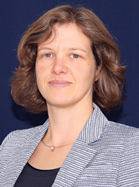Prof. Iris Vis: ‘Switch to large-scale use of LNG golden opportunity for the Netherlands’ (video)

A new distribution network is needed to enable the broad acceptance of environmentally friendly fuels such as LNG (and bio-LNG). Supply and demand must go hand in hand. The facilities thus developed will boost the Netherlands’ position as a transport country and distributor of LNG. Furthermore, the logistical knowledge acquired will itself be an excellent export product. These are the words of Iris Vis, Professor of Industrial Engineering at the University of Groningen.
Vis is heading the Dinalog ‘Design of LNG networks’ project, a collaboration between the University of Groningen, Eindhoven University of Technology and the business sector, which aims to get the use of LNG as a transport fuel off the ground in the Netherlands. ‘Developing a distribution network for LNG is potentially a golden opportunity for the Netherlands to maintain its role at the forefront of gas distribution. For example, LNG is one of the fuels that will enable maritime ships to satisfy the more stringent emission requirements coming into force in 2015.’
Logistical challenge
LNG is gaining momentum. It is a relatively clean fuel which, unlike gas, can be transported in tankers and ships. The logistics are still proving a challenge though, partly due to the lack of a distribution network of bunker terminals and filling stations. This means that at present, a tanker may have to follow a river transport vessel to supply it with the LNG it needs for the journey.
Chicken or egg
LNG producers and users have now joined forces to find a solution to this problem. Vis: ‘It’s a chicken or egg problem’. The transporters are waiting for filling stations, and vice versa. So we’re now sitting round the table with a frontline group of infrastructure providers (such as Gasunie, Vopak and GDF Suez), facility companies (such as Groningen Seaports), and logistics providers (such as Jan de Rijk Logistics and Intermodal Solutions).’
Blueprint
The Dinalog project ‘Design of LNG networks’ is focusing on the logistical aspects of the distribution and transport of LNG (and bio-LNG). ‘The parties involved are trying to design tools that will help with investment and infrastructural decisions, and economic and market analyses. They are also developing a blueprint of the LNG distribution chain, to get an idea of possible short and long-term locations for filling stations (fixed or mobile) and bunker facilities, for example. The blueprint will help to predict trends in demand and work out the best ways and places to supply the fuel.’
Economic impulse
Whatever else, the transition to LNG will provide a strong economic impulse, says Vis. ‘Cargo ships and vehicles will need to be converted or replaced, and we will need investment in filling stations and terminals. The Green Deal, as it is called, sets out clear agreements for the years to come: fifty maritime ships and five river vessels will sail on LNG, and five hundred lorries will also make the switch.
Curriculum Vitae
Prof. Iris Vis is Professor of Industrial Engineering at the University of Groningen.
| Last modified: | 01 February 2023 10.56 a.m. |
More news
-
19 April 2024
New thesis prize for master's students of Economics and Business
How can we encourage economics and business students to deal with important societal challenges in their master's thesis? The 14 Dutch faculties of economics and business, united in the Council of Deans in Economics and Business (DEB), have set up...
-
18 April 2024
Ward Romeijnders appointed as Professor of Optimization under Uncertainty
The Faculty of Economics and Business is pleased to announce that Ward Romeijnders has been appointed as Professor of Optimization under Uncertainty. The chair is situated within the Department of Operations.
-
12 April 2024
Inaugural Lecture Corine Noordhoff: Future ready retail
In her inaugural lecture, Professor of Retail Marketing Corine Noordhoff will provide insights in the cornerstones for survival and adaptation in the retail sector. Noordhoff’s inaugural lecture will take place on Friday 19 April 2024, 16:15 –...
